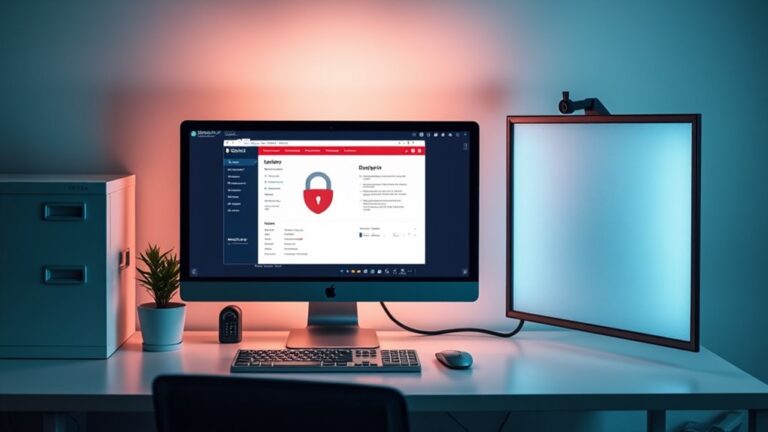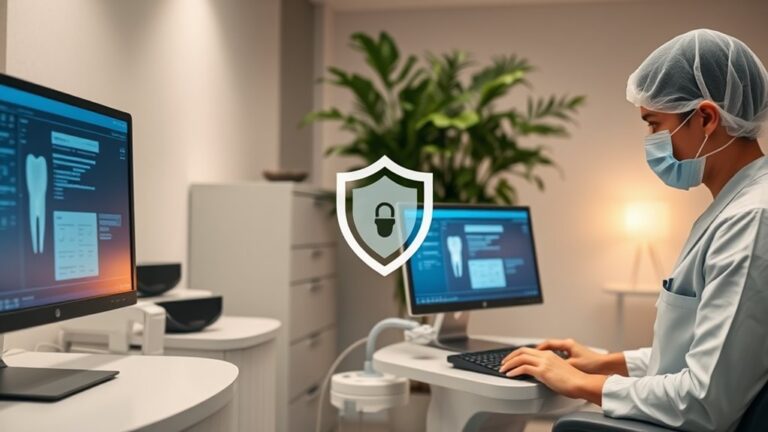Safeguarding Patient Data: 7 Cybersecurity Essentials Online
Did you know that over 80% of healthcare organizations have experienced a data breach in the past two years? This alarming statistic highlights the urgent need for robust cybersecurity measures in safeguarding patient data. You might wonder what specific steps you can take to ensure your organization isn't part of this troubling trend. Let's explore seven essential cybersecurity practices that can not only protect sensitive information but also enhance your compliance with regulations like HIPAA. If you're looking for expert guidance on implementing these practices, feel free to contact us; we can connect you with professionals who can provide tailored solutions to safeguard your organization.
Implement Firewalls and Network Security
Implementing robust firewalls and network security measures is essential for protecting patient data in healthcare environments. You need to guarantee proper firewall configurations to manage access controls effectively, limiting exposure to protected health information (PHI) to authorized personnel only.
Deep packet inspection plays a significant role in analyzing network traffic, allowing you to detect and prevent potential threats in real time. In addition, cybersecurity threats are constantly evolving, making it critical to continuously assess and update your security strategies to stay ahead.
Network segmentation is another important strategy. By isolating critical systems from less sensitive areas, you can contain the impact of any breaches that may occur, enhancing overall security.
It's imperative to maintain audit trails and detailed logs for compliance audits, assuring you can track network activities and demonstrate adherence to regulations.
Incorporating intrusion detection and prevention systems (IDS/IPS) will further bolster your defenses against various attacks, including malware and zero-day threats.
Additionally, integrating threat intelligence enables you to adapt firewall rules based on evolving cyber threats. By prioritizing these strategies, you'll create a robust security posture, safeguarding patient data while fulfilling your commitment to serving others in the healthcare sector.
Use Antivirus and Malware Protection
Alongside firewalls and network security, employing antivirus and malware protection forms an essential layer in safeguarding patient data from cyber threats. This proactive approach leverages real-time detection capabilities to identify and neutralize ransomware, malware, and other malicious attacks as they emerge.
By utilizing advanced techniques like machine learning and behavioral analysis, your systems can continuously monitor activity for suspicious behavior, alerting administrators about potential threats. Furthermore, the healthcare sector is a prime target for cybercriminals due to the value of patient data, making robust antivirus solutions even more critical.
Automated remediation and response features greatly enhance your cybersecurity posture. When a threat is detected, the system can automatically quarantine and remove it, minimizing risk without requiring manual intervention. This not only saves IT resources but also guarantees a prompt response to detected malware, helping maintain operational continuity and preventing system downtime.
Moreover, effective antivirus and malware protection safeguards critical healthcare systems, guaranteeing the integrity of patient data while complying with regulations like HIPAA.
Encrypt Sensitive Data
When it comes to protecting patient data, encryption is an essential safeguard that renders sensitive information unreadable to unauthorized users. By implementing effective encryption techniques, you greatly reduce the risk of data breaches and unauthorized access, which can lead to legal and financial repercussions for your organization.
Encryption not only protects data but also guarantees its integrity, preventing unauthorized modifications that could compromise patient care. Utilizing methods like Advanced Encryption Standard (AES) provides robust security for healthcare data, while symmetric and asymmetric encryption cater to different operational needs. Additionally, regular risk assessments help identify vulnerabilities and ensure encryption measures are effectively applied.
Remember to encrypt data both at rest and in transit to achieve thorough protection.
Adhering to HIPAA and GDPR regulations, you must employ encryption methods consistent with National Institute of Standards and Technology (NIST) standards. This compliance safeguards the confidentiality, integrity, and availability of electronic protected health information (ePHI).
Lastly, protect your encryption devices and keys physically and manage them securely. By prioritizing encryption, you not only enhance data security but also foster trust with patients, guaranteeing that their sensitive information remains confidential and secure.
Conduct Regular Software Updates
Regular software updates are essential for safeguarding patient data and maintaining the integrity of healthcare systems. By adhering to a consistent update frequency, you can effectively manage vulnerabilities within your software environment. This proactive measure not only protects sensitive patient data but also guarantees compliance with regulatory standards.
Consider the following benefits of regular software updates:
- Protects Against Vulnerabilities: Closing known flaws prevents exploitation by cybercriminals and reduces the risk of data breaches.
- Enhances Functionality: Updates often include bug fixes and new features, improving overall system performance and user experience. Additionally, incremental improvements make software operation more efficient.
- Strengthens Cybersecurity: Incorporating updated software enhances your cybersecurity framework, implementing defenses against evolving threats.
Establish Access Controls
Establishing access controls is vital for protecting patient data and guaranteeing that only authorized personnel can interact with sensitive information. Implementing a robust role-based access control (RBAC) model allows you to assign user permissions based on job roles, automatically restricting access to high-risk areas like maternity wards or server rooms. This approach not only enhances security but also supports compliance with regulations such as HIPAA. Additionally, effective access control systems are crucial for managing entries and exits, ensuring safety for both staff and patients.
Credential management is essential in this process. By utilizing multi-factor authentication (MFA), you can verify user identities through multiple validation methods, reducing the risk of unauthorized access. It's imperative to establish clear security policies that dictate how access is granted and monitored.
Regular access audits and compliance monitoring guarantee that your access controls remain effective. Real-time monitoring can alert you to suspicious activities, while detailed access logs provide accountability.
Train Employees on Cybersecurity
After implementing effective access controls, the next essential step in safeguarding patient data is training employees on cybersecurity. Your staff must understand the specific threats in healthcare, such as phishing, ransomware, and social engineering. By promoting cyber hygiene, you can empower them to recognize and respond to these risks effectively. To support this initiative, consider utilizing free online training programs launched by HHS that focus on critical areas like social engineering and ransomware.
To create a robust training program, focus on the following key areas:
- Phishing Awareness: Teach employees to identify red flags like misspellings and generic greetings in emails.
- Simulated Phishing Exercises: Conduct regular phishing simulations to test their skills and provide immediate feedback.
- Ongoing Education: Use engaging methods like videos and quizzes to keep your team informed about emerging threats.
Encouraging a culture of security awareness among all staff members is vital. Regular awareness campaigns and involvement from leadership can enhance engagement.
Perform Risk Assessments
Performing risk assessments is essential in the ongoing effort to protect patient data in healthcare settings. Start by conducting thorough asset identification, cataloging all critical assets, including technology, patient data, facilities, equipment, and human resources. Use Master Data Management (MDM) to centralize this data, guaranteeing you capture sensitive information and role-based access controls.
Next, engage in risk identification by systematically analyzing each area of your operations. Use methods such as direct observation, data reviews, and surveys to uncover potential internal and external risks, data vulnerabilities, and technology weaknesses. Identify threats like data breaches and unauthorized access, prioritizing them based on their likelihood and potential impact. Risk assessment is crucial for ensuring adherence to legal and industry regulations, which ultimately protects both the organization and its patients.
Once risks are identified, perform a detailed risk evaluation. Analyze the collected data to assess risks quantitatively or qualitatively, comparing them against predefined criteria for acceptability. This allows you to categorize risks as low, medium, or high and focus on root causes to optimize mitigation strategies.
Collaboratively develop actionable plans, assign responsibilities, and document everything to guarantee accountability. Regularly revisit these assessments to adapt to evolving threats and maintain a resilient cybersecurity posture.
Frequently Asked Questions
What Are the Signs of a Data Breach in Healthcare?
You should look for signs of unauthorized access, unusual data transmission, and financial discrepancies. Implement breach detection tools and conduct regular security training to empower your team in identifying potential data breaches proactively.
How Often Should Cybersecurity Audits Be Conducted?
How often do you want to risk a data breach? Cybersecurity audit frequency should align with your organization's risk profile. Follow audit process guidelines, conducting reviews at least annually, or quarterly for high-risk sectors like healthcare.
What Is the Role of Third-Party Vendors in Data Security?
Third-party vendors play an essential role in data security. You must assess vendor risk, ensuring they implement data encryption and adhere to security standards, protecting sensitive information while maintaining compliance and minimizing vulnerabilities in your network.
How Can Patients Protect Their Data Privacy?
To protect your data privacy, utilize data encryption for sensitive information and prioritize patient education. Stay informed about data protection practices, and actively engage in discussions with healthcare providers about safeguarding your personal health information.
What Legal Consequences Exist for Data Breaches in Healthcare?
Imagine a hospital facing $6.85 million in regulatory penalties due to a data breach. You must guarantee timely breach notifications to affected individuals, as failure can escalate fines and harm your organization's reputation.
Conclusion
In the world of healthcare, the adage "an ounce of prevention is worth a pound of cure" rings true. By implementing robust firewalls, using antivirus solutions, encrypting sensitive data, and training your staff, you're not just safeguarding patient information—you're building a resilient defense against cyber threats. Regular software updates and thorough risk assessments keep your systems secure and compliant.
If you find these cybersecurity essentials overwhelming, don't hesitate to reach out to us for assistance. Our expert help can save you time, reduce stress, and significantly enhance the security of your dental practice. Prioritize these measures today, and protect the integrity of your healthcare delivery tomorrow with our support.





